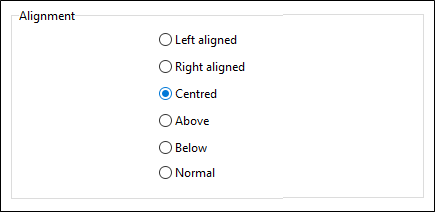Property Editor: Field Label Hyperlink
To set the properties of a Field Label Hyperlink, click on the Field Label Hyperlink template (either in the templates list or in the report) and select the Properties menu option to display the Field Label Hyperlink Property Editor. Alternatively right-click and select Properties from the right-click menu.
General
On the General tab, identify the template object and specify size, position, border and visibility options.
Identity
The Name attribute is used to identify the template in the Templates list. Template names must be unique. Choose a short but descriptive name which includes the template type and data category.
To avoid potential problems, avoid using spaces or special characters in template names.
Optionally enter a Description that describes what data is associated with the template object.
Size and Position
The template position is specified relative to the top left corner of the drawing area. The left co-ordinate (X) gives the offset from the left edge of the drawing area to the left edge of the template. The top co-ordinate (Y) gives the offset in millimetres from the top of the drawing area to the top of the template. These measurements do not include the page margins. Furthermore, scale bars have annotation margins which are also not included in the measurements. The co-ordinates of a scale bar refer to the top left corner of the bar itself.
Use the Width and Height properties of the object to adjust the size of the template object in the report. Keep the aspect ratio the same in order to prevent distortion of the image.
Border Style
Specify whether or not a rectangular border should be drawn around the template object. If you choose to draw a border, choose a single or double line style.
Allow custom border size
If you have chosen to draw a border around the template object, select this option to set a custom width and height for the border. Custom width and height input boxes will appear on the dialog.
An Alignment group will also appear on the Annotation tab, which allows you set the alignment of the text within the custom border.
Visibility
Select the Hide this object option to hide the template object. The template will still be available for selection in the Templates list, but will not be visible in the report.
Data
Data Source (Display)
A ' data-aware' template type, derives its data from one or more datasets. Select a display dataset and a source column (field) from the drop-down list.
Data Source (Hyperlink Target Text)
The Graphic Reporter supports "on-the-fly" decoding, eliminating the need for decoded extract tables. During the decoding process, the coded value of the source field is translated to its associated description by performing a code lookup against a nominated code table. All the parameters needed for this process must be defined at design time, including:
- the Hyperlink Target Text Lookup Data Set (which must be included as one of the datasets in the report);
- the Lookup Code column (field in the lookup table) that is used as the lookup key;
- the Description column (field in the lookup table) that contains the full description for the code.
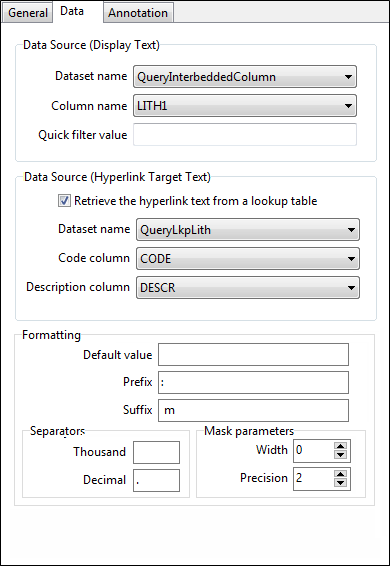
The formatting and decoding parameters displayed above are applicable to the chosen Column (LITH1).
The code in this field will be translated to its full description using the QueryLkpLith dataset, using CODE as the matching key field and returning the content of field DESCR as the text to display.
Formatting is done implicitly using separate Width, Precision, Prefix and Suffix fields (which can be blank). The Format string is compiled according to the following rule: Prefix + %[Width].[Precision][Type] + Suffix.
Options for Thousand and Decimal separators are also available.
Note that blanks can also be used in the prefix and suffix.
Annotation
Select the font style, font size, and text Colour to be used for the annotation. You can also set the orientation of the text.
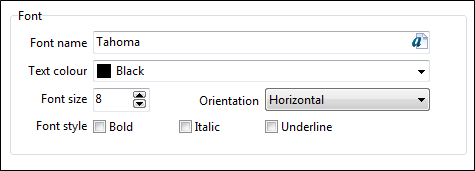
The characters in a vertical column are rotated 90 degrees anti-clockwise (up) or 270 degrees anti-clockwise (down). The characters in a stacked column are not rotated, but simply displayed vertically, as illustrated in the example below:
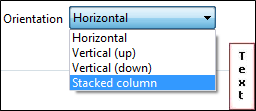
This option is enabled for Text labels, Field Labels, Date labels and Hyperlink labels.
Some printer drivers do not support the technique used to render the stacked text. Generally speaking, colour printers will support the feature, while black and white printers will not. If your printer fails to display stacked text, try setting the raster graphics options for the printer and try again.
Alignment
If you have chosen to draw a border and have set a custom border width and height on the General tab, an Alignment group will be enabled on the Annotation tab, which allows you set the alignment of the text within the custom border.
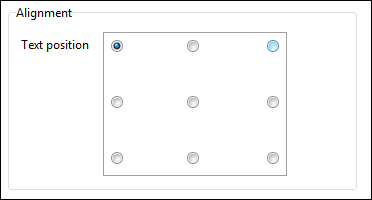
If you have chosen not to custom size the border, the following alignment options are provided instead:
Set the alignment of the label annotation.
